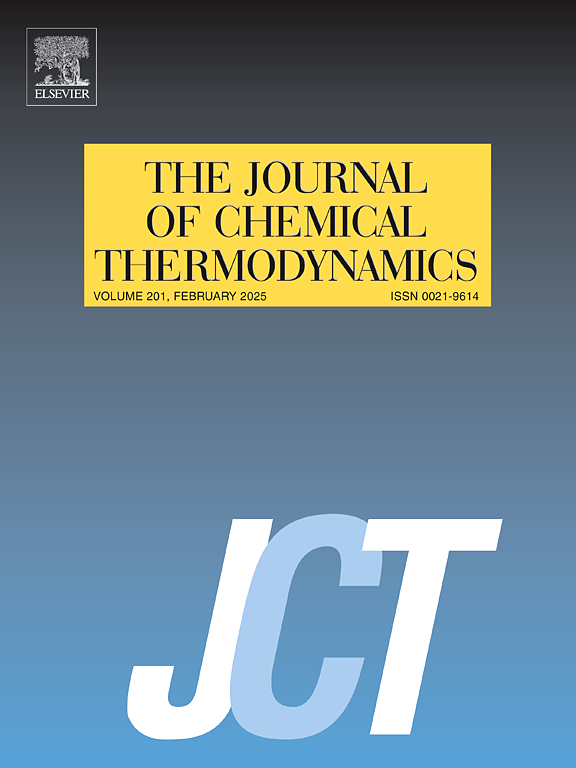Volumetric properties modeling of unsaturated solutions in the Li–Na–K–Cl–H2O system from 288.15 to 323.15 K and at 101.3 kPa using the Pitzer equations
IF 2.2
3区 工程技术
Q3 CHEMISTRY, PHYSICAL
引用次数: 0
Abstract
This work presents a modeling approach to describe the volumetric properties of unsaturated solutions in the quaternary Li–Na–K–Cl–H2O system from 288.15 to 323.15 K and at 101.3 kPa using the Pitzer equations. This system is a key component of the electrolytic environment found in brines extracted from the Salar de Atacama in Chile, which are used to produce lithium compounds.
The densities measured in this study, validated against data from the literature, showed trends consistent with changes in concentration and temperature, where KCl(aq) exerts the greatest influence on solution density.
New volumetric parameters for the LiCl – H2O system at 323.15 K were obtained, and volumetric interaction coefficients in ternary mixtures were determined as a function of temperature, thereby expanding the existing database. The resulting standard deviations were low (below 1 %), demonstrating the model robustness in predicting volumetric properties for complex multi–component systems.
The volumes of mixing analysis revealed significant structural changes in these solutions: NaCl(aq) and LiCl(aq) act as structure breakers of water, while KCl(aq) exhibits dual behavior depending on the solution composition and total ionic strength. This information is valuable for understanding the structural nature of concentrated solutions and their impact on industrial processes to produce lithium compounds from brines.
288.15 ~ 323.15 K和101.3 kPa下Li-Na-K-Cl-H2O体系中不饱和溶液的体积性质用Pitzer方程建模
本文提出了一种利用Pitzer方程来描述在288.15 ~ 323.15 K和101.3 kPa条件下,四元Li-Na-K-Cl-H2O体系中不饱和溶液的体积特性的建模方法。该系统是智利阿塔卡马盐湖(Salar de Atacama)提取的盐水中电解环境的关键组成部分,用于生产锂化合物。本研究中测量的密度,与文献数据相对照,显示出与浓度和温度变化一致的趋势,其中KCl(aq)对溶液密度的影响最大。在323.15 K下获得了LiCl - H2O体系的新体积参数,并确定了三元混合物中体积相互作用系数随温度的函数,从而扩展了现有数据库。得到的标准偏差很低(低于1%),表明该模型在预测复杂多组分体系的体积特性方面具有稳健性。混合体积分析表明,这些溶液的结构发生了显著变化:NaCl(aq)和LiCl(aq)是水的结构破坏者,而KCl(aq)则根据溶液组成和总离子强度表现出双重行为。这些信息对于理解浓缩溶液的结构性质及其对从盐水中生产锂化合物的工业过程的影响是有价值的。
本文章由计算机程序翻译,如有差异,请以英文原文为准。
求助全文
约1分钟内获得全文
求助全文
来源期刊

Journal of Chemical Thermodynamics
工程技术-热力学
CiteScore
5.60
自引率
15.40%
发文量
199
审稿时长
79 days
期刊介绍:
The Journal of Chemical Thermodynamics exists primarily for dissemination of significant new knowledge in experimental equilibrium thermodynamics and transport properties of chemical systems. The defining attributes of The Journal are the quality and relevance of the papers published.
The Journal publishes work relating to gases, liquids, solids, polymers, mixtures, solutions and interfaces. Studies on systems with variability, such as biological or bio-based materials, gas hydrates, among others, will also be considered provided these are well characterized and reproducible where possible. Experimental methods should be described in sufficient detail to allow critical assessment of the accuracy claimed.
Authors are encouraged to provide physical or chemical interpretations of the results. Articles can contain modelling sections providing representations of data or molecular insights into the properties or transformations studied. Theoretical papers on chemical thermodynamics using molecular theory or modelling are also considered.
The Journal welcomes review articles in the field of chemical thermodynamics but prospective authors should first consult one of the Editors concerning the suitability of the proposed review.
Contributions of a routine nature or reporting on uncharacterised materials are not accepted.
 求助内容:
求助内容: 应助结果提醒方式:
应助结果提醒方式:


